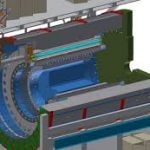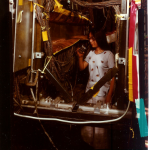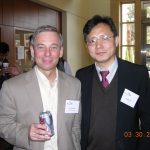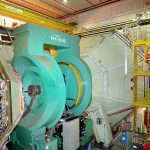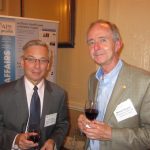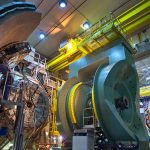Throughout my career, I’ve had an interest in developing models to understand various aspects of particle production and correlations in hadronic and nuclear collisions. Here are various papers I have written or co-authored along these lines:
- Assessing saturation physics explanations of collectivity in small collision systems with the IP-Jazma model (2018), co-authored with Jamie Nagle. This paper was motivated by two theoretical calculations that provided a good description of the PHENIX results on collective behavior in small nuclear systems. However, the physical mechanisms at play were puzzling to us, based on dimensional considerations, and it was subsequently determined there was a numerical error in their calculations.
- Small System Collectivity in Relativistic Hadronic and Nuclear Collisions (2007), co-authored with Jamie Nagle. This is a review article examining the experimental evidence for and theoretical explanations of the collective behavior observed in nuclear collisions. Our conclusion:
In summary, ample theoretical arguments developed over the past decade suggest that viscous relativistic hydrodynamics can be applied to describe particle production and flow in p+p and p+A collisions at high energies…The insights derived from this ongoing work have greatly extended the regimes in which we can apply properly-formulated relativistic viscous hydrodynamics, with implications for many-body strongly coupled systems in other fields of physics.
- Quark-Gluon Plasma at RHIC and the LHC: Perfect Fluid too Perfect? (2011), co-authored with Ian Bearden and Jamie Nagle. This paper takes a critical look at parameterizations purporting to provide quick access to transport properties of the quark-gluon plasma.
- Quantitative and Conceptual Considerations for Extracting the Knudsen Number in Heavy Ion Collisions (2010), co-authored with Peter Steinberg and Jamie Nagle. This paper looks at neglected systematic uncertainties in extracting the Knudsen number K and shear viscosity to entropy density ratio η/s from experimental data. Looking back on it from a 2020 perspective (no pun intended), I think we perhaps could have better emphasized the parton cross sections we were extracting (a few millibarns). It is also interesting that we discussed the uncertainty in the “two-component” parameterization of particle multiplicities, an approach that was effectively laid to rest by this subsequent 2013 PHENIX paper.
- The Fluid Nature of Quark-Gluon Plasma (2007). A status report on the field at the time. I am pleased that the concluding sentence of the abstract “The current status of the RHIC experimental studies is presented, with a special emphasis on the fluid properties of the created matter, which may in fact be the most perfect fluid ever studied in the laboratory” has held up rather well over time.
- Bose-Einstein or HBT correlations and the anomalous dimension of QCD (2004), with co-authors T. Csörgo, S. Hegyi and T. Novák. At the time I thought the possible relation between the anomalous dimension of QCD and the structure of HBT correlations was a bit of a reach, but based on the superb work found in Felix Clark’s thesis on ATLAS results, this would be worth revisiting.
- Bose-Einstein correlations for Levy stable source distributions (2003), with co-authors T. Csörgo and S. Hegyi. This paper introduced Levy distributions as a means to characterize “long-tailed” source distributions which result in “sharper” correlation functions than Gaussians.
- Imaging the final-state phase space in heavy-ion collisions (1998). This was the conference proceedings for the Nucleus-Nucleus 1997 conference, in which I noted the utility of Gaussian functions with correlated coordinate and momentum space emission functions for analytically testing various Wigner function approximations in calculating HBT correlations. It should have been written up as a real paper, but this conference was just a few weeks before I became PHENIX spokesperson, so that never happened.
- Coulomb corrections in two particle correlations for the processes of high multiplicity (1996), with co-authors Dmitry (Dima) Anchishkin and Gennady (Gena) Zinovjev. This paper examined the role of the pion pair velocity in the “standard” Gamov correction factor, providing simple pocket formulas to estimate the effects from the pair’s motion through the medium.
- Coalescence production of H0s in p A collisions (1995), with co-authors Brian Cole and Matt Moulson. This paper, which resulted from work on the proposal for the E910 experiment, estimated the production rate of the hypothesized doubly-strange H0 dibaryon.
- Interferometry: New ideas and new directions (1991). This is the write-up of my invited plenary talk at the Quark Matter 1990 conference (in the spectacular setting of Menton, France), where I explored the Lorentz properties of HBT radii.
- Monte Carlo Calculational Methods for the Generation of Events with Bose-Einstein Correlations (1986). In this paper I developed a Monte Carlo (Metropolis) procedure for generating n-pion events with complete Bose-Einstein correlations between the particles. This is amenable to direct calculation for values of n up to ~20 (using the computer technology of the time!), beyond that required a Monte Carlo of the Monte Carlo, but this did succeed in producing nice “speckle” patterns of pion clusters and the correct negative-binomial phase space clustering.
- KNO Scaling Isn’t What It Used To Be (1986). This is really a combination of two minor observations: 1) What people commonly refer to as KNO scaling (scaling of the higher-order moments with the mean multiplicity) was really an approximation to what Koba, Nielsen and Olesen really predicted (scaling of the factorial moments, as found in negative-binomial distributions) and 2) Assuming particle production of negative-binomial distributions of parents, binomial (random) sampling of children was also negative-binomial, and that this mechanism provided a nice description of the neutral-charged correlation coefficient variation with multiplicity.

